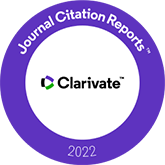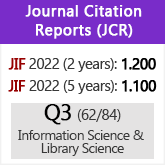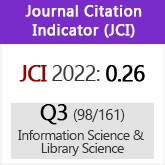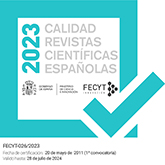Grouping of Spanish universities in the national print media
DOI:
https://doi.org/10.3989/redc.2016.2.1292Keywords:
University, print press, local press, branding, mappingAbstract
Scientific and social activities from the academic world are frequently reflected in media outlets at a local, regional, national or international level, based on the interest of the news item and its target audience. Traditionally, universities have been mapped by measuring common areas such as scientific output. The current study proposes a visualization of similarities among Spanish universities through their presence in the national, regional and local press. To this end, we analyze the news published in the print media during September and October 2014 and retrieved from MyNews Online, which amounted to 27,170 news items. The results show how the geographic component is the main binding element of universities when their news are analyzed. This indicates that Spanish universities’ brands usually have a strong regional character.
Downloads
References
Adams, R.H. (1970). Determination and Comparison of Biological Principles in the Public Press and in BSCS Biology text. Corvallis; Oregon State University.
Aguillo, I.; Ortega, J.; Fernández, M. (2008). Webometric ranking of world universities: Introduction, methodology, and future developments. Higher Education in Europe, 33 (2-3), 233-244. http://dx.doi.org/10.1080/03797720802254031
Aspara, J.; Aula, H.-M.; Tienari, J.; Tikkanen, H. (2014). Struggles in organizational attempts to adopt new branding logics: the case of a marketizing university. Consumption Markets & Culture, 17 (6), 522-552. http://dx.doi.org/10.1080/10253866.2013.876347
Batagelj, V.; Mrvar, A. (2002). Pajek—analysis and visualization of large networks. En: Mutzel, P.; Jünger, M.; Leipert S. (editores). Graph Drawing, 8–11. Springer. http://dx.doi.org/10.1007/3-540-45848-4_54
Bornmann, L.; Moya, F.D.; Leydesdorff, L. (2012). The new Excellence Indicator in the World Report of the SCImago Institutions Rankings 2011. Journal of Informetrics, 6 (2), 333–335. http://dx.doi.org/10.1016/j.joi.2011.11.006
Carrillo, M.V.; Castillo, A.; Blasco, T. (2013). La transmisión de marca de las universidades españolas en sus webs. Historia Y Comunicación Social, 18 (especial octubre), 195–205.
Chapleo, C. (2004). Interpretation and implementation of reputation/ brand management by UK university leaders. International Journal of Educational Advancement, 5 (1), 7–23. http://dx.doi.org/10.1057/palgrave.ijea.2140201
Eck, N.V.; Waltman, L.; Dekker, R.; Berg, J.V.D. (2010). A comparison of two techniques for bibliometric mapping: Multidimensional scaling and VOS. Journal of the American Society for Information Science, 61 (12), 2405–2416. http://dx.doi.org/10.1002/asi.21421
Feijóo, B. (2013). La proyección pública de la Universidad de Vigo a través de su diario digital. Estudios Sobre El Mensaje Periodístico, 19 (especial), 159–167.
Finley, C.W.; Caldwell, O.W. (1923). Biology in the Public Press. New York City; Lincoln School of Teachers College. PMid:20314704 PMCid:PMC1707214
González-Ria-o, M.G.; Repiso, R.; López-Cózar, E.D. (2014). Repercusión de los rankings universitarios en la prensa española. Revista Española de Documentación Científica, 37 (3), 1–9.
Guallar, J.; Abadal, E. (2009). Evaluación de hemerotecas de prensa digital: indicadores y ejemplos de buenas prácticas. El Profesional de La Informacion, 18, 255– 269. http://dx.doi.org/10.3145/epi.2009.may.02
Hemsley-Brown, J.; Goonawardana, S. (2007). Brand harmonization in the international higher education market. Journal of Business Research, 60 (9), 942–948. http://dx.doi.org/10.1016/j.jbusres.2007.01.019
Herrero-Solana, V.; Arboledas, L.; Legerén-Álvarez, E. (2014). Universidades y Google News : visibilidad internacional a través de los medios de comunicación online. Revista Española de Documentación Científica, 37 (3), e052. http://dx.doi.org/10.3989/redc.2014.3.1130
Galcerán Huguet, M. (2010). La mercantilización de la universidad. Revista electrónica interuniversitaria de formación del profesorado, 33(13-2), 19-28.
Kamada, T.; Kawai, S. (1988). A simple method for computing general position in displaying three-dimensional objects. Computer Vision, Graphics, and Image Processing, 41 (1), 43–56. http://dx.doi.org/10.1016/0734-189X(88)90116-8
Kim, S. H.; Brunner, B.R.; Fitch-Hauser, M. (2006). Exploring community relations in a university setting. Public Relations Review, 32 (2), 191–193. http://dx.doi.org/10.1016/j.pubrev.2006.02.018
Kim, S.H.; Carvalho, J.P.; Cooksey, C.E. (2007). Exploring the effects of negative publicity: News coverage and public perceptions of a university. Public Relations Review, 33 (2), 233–235. http://dx.doi.org/10.1016/j.pubrev.2007.02.018
Kohring, M.; Marcinkowski, F.; Lindner, C.; Karis, S. (2013). Media orientation of German university decision makers and the executive influence of public relations. Public Relations Review, 39 (3), 171–177. http://dx.doi.org/10.1016/j.pubrev.2013.01.002
Legerén, E. (2014). Visibilidad de las universidades andaluzas en los medios de comunicación on-line a través de Google News. Tesis doctoral. Universidad de Granada. PMid:25289098 PMCid:PMC4186558
Leydesdorff, L.; Persson, O. (2010). Mapping the geography of science: Distribution patterns and networks of relations among cities and institutes. Journal of the American Society for Information Science and Technology, 61 (8), 1622–1634. http://dx.doi.org/10.1002/asi.21347
Melewar, T.C.; Akel, S. (2005). The role of corporate identity in the higher education sector: A case study. Corporate Communications: An International Journal, 10 (1), 41–57. http://dx.doi.org/10.1108/13563280510578196
Münch, R. (2010). Der Monopolmechanismus in der Wissenschaft. Berliner Journal Für Soziologie, 20 (3), 341–370. http://dx.doi.org/10.1007/s11609-010-0132-x
Ortega, J.; Aguillo, I.; Cothey, V.; Scharnhorst, A. (2008). Maps of the academic web in the European Higher Education Area—an exploration of visual, Scientometrics, 6, 1–20. http://dx.doi.org/10.1007/s11192-008-0218-9
Ortega, J.L.; Aguillo, I.F. (2009). Mapping world-class universities on the web. Information Processing and Management, 45 (2), 272–279. http://dx.doi.org/10.1016/j.ipm.2008.10.001
Peters, H.P.; Brossard, D.; De Cheveigné, S.; Dunwoody, S.; Kallfass, M.; Miller, S.; Tsuchida, S. (2008). Science communication. Interactions with the mass media. Science, 321 (5886), 204–205. http://dx.doi.org/10.1126/science.1157780 PMid:18625578
Raupp, J. (2012). Mediatization of society. Consequences for organizational communication. Comunicação E Sociedade, 8, 201-208. Retrieved from http://www.lasics.uminho.pt/OJS/index.php/ comsoc/article/view/1191 [Consulta: 18/03/2015].
Repiso, R.; Rodríguez-Pinto, M.Á.; García García, F. (2013). Posicionamiento y agrupación de la prensa española : análisis de contenido de las noticias generadas en la Jornada Mundial de la Juventud 2011. Estudios Sobre El Mensaje Periodístico, 19 (2), 1091–1106.
Riffe, D.; Aust, C.F.; Lacy, S.R. (1993). The Effectiveness of Random, Consecutive Day and Constructed Week Sampling in Newspaper Content Analysis. Journalism & Mass Communication Quarterly, 70 (1), 133–139. http://dx.doi.org/10.1177/107769909307000115
Riffe, D.; Lacy, S., Drager, M.W. (1996). Sample Size in Content Analysis of Weekly News Magazines. Journalism & Mass Communication Quarterly, 73 (3), 635–644. http://dx.doi.org/10.1177/107769909607300310
Robinson-García, N.; Rodríguez-Sánchez, R.; García, J.A.; Torres-Salinas, D. (2013). Análisis de redes de las universidades españolas de acuerdo a su perfil de publicación en revistas por áreas científicas. Revista Española de Documentación Científica, 36 (4), 1–16.
Robinson-García, N.; Torres-Salinas, D.; Delgado López-Cózar, E.; Herrera, F. (2014). An insight into the importance of national university rankings in an international context: the case of the I-UGR rankings of Spanish universities. Scientometrics, 101 (2), 1309–1324. http://dx.doi.org/10.1007/s11192-014-1263-1
Rowe, D. (2005). Working Knowledge Encounters: Academics, Journalists and the Conditions of Cultural Labour. Social Semiotics, 15 (3), 269–288. http://dx.doi.org/10.1080/10350330500310046
Rowe, D.; Brass, K. (2008). The uses of academic knowledge: the university in the media. Media, Culture & Society, 30 (5), 677–698. http://dx.doi.org/10.1177/0163443708094015
Scheufele, D.A.; Shanahan, J.; Kim, S.-H. (2002). Who Cares about Local Politics? Media Influences on Local Political Involvement, Issue Awareness, and Attitude Strength. Journalism & Mass Communication Quarterly, 79 (2), 427–444. http://dx.doi.org/10.1177/107769900207900211
Scott, P. (1987). Los receptores finales de la información científica y universitaria. En: Consejo de Universidades (editor). Universidad y medios de comunicación. Jornadas de periodismo científico y universitario en el marco europeo. Madrid, Consejo de Universidades.
Torres-Salinas, D.; Delgado-López-Cózar, E.; García- Moreno-Torres, J.; Herrera, F. (n.d.). Rankings ISI de las Universidades Españolas según Campos Científicos: descripción y resultados. El Profesional de La Información.
Vargas-Quesada, B. (2005). Visualización y análisis de grandes dominios científicos mediante redes pathfinder (PFNET). Tesis doctoral. Universidad de Granada. Retrieved [01.06.2015] from http://hdl. handle.net/10481/590
Wæraas, A.; Solbakk, M.N. (2009). Defining the essence of a university: Lessons from higher education branding. Higher Education, 57 (4), 449– 462. http://dx.doi.org/10.1007/s10734-008-9155-z
Published
How to Cite
Issue
Section
License
Copyright (c) 2016 Consejo Superior de Investigaciones Científicas (CSIC)

This work is licensed under a Creative Commons Attribution 4.0 International License.
© CSIC. Manuscripts published in both the printed and online versions of this Journal are the property of Consejo Superior de Investigaciones Científicas, and quoting this source is a requirement for any partial or full reproduction.All contents of this electronic edition, except where otherwise noted, are distributed under a “Creative Commons Attribution 4.0 International” (CC BY 4.0) License. You may read here the basic information and the legal text of the license. The indication of the CC BY 4.0 License must be expressly stated in this way when necessary.
Self-archiving in repositories, personal webpages or similar, of any version other than the published by the Editor, is not allowed.

















